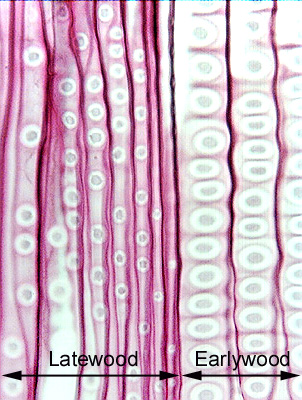|
[Home]
[Up]
| |
 Fig.
15.2-12. Radial section of pine wood. The latewood tracheids on the
left are such narrow cells that their circular bordered pits must be small to
fit on their small radial walls. The earlywood tracheids, however, are so large
that their radial walls have plenty of room for large circular bordered pits. Of
course, it is theoretically possible for the earlywood tracheids to have two
rows of small circular bordered pits, but that does not happen in most conifers
(it does happen in Araucaria, however, the genus of Norfolk Island pine
and Monkey puzzle trees). Fig.
15.2-12. Radial section of pine wood. The latewood tracheids on the
left are such narrow cells that their circular bordered pits must be small to
fit on their small radial walls. The earlywood tracheids, however, are so large
that their radial walls have plenty of room for large circular bordered pits. Of
course, it is theoretically possible for the earlywood tracheids to have two
rows of small circular bordered pits, but that does not happen in most conifers
(it does happen in Araucaria, however, the genus of Norfolk Island pine
and Monkey puzzle trees).
Even though there is no ray present in this
micrograph, you can still tell it is a radial section. How? 1) It
cannot be a transverse section because the tracheids are long as in a
longitudinal section not round as in a transverse section. 2) The circular
bordered pits are abundant, and that is true only of radial walls in conifer
wood. 3) There is a transition from the latewood of one year to the earlywood of
the following year; a tangential section would almost certainly have been cut
through just latewood or just earlywood, not both unless it was not a truly
tangential section.
|
 Fig.
15.2-12. Radial section of pine wood. The latewood tracheids on the
left are such narrow cells that their circular bordered pits must be small to
fit on their small radial walls. The earlywood tracheids, however, are so large
that their radial walls have plenty of room for large circular bordered pits. Of
course, it is theoretically possible for the earlywood tracheids to have two
rows of small circular bordered pits, but that does not happen in most conifers
(it does happen in Araucaria, however, the genus of Norfolk Island pine
and Monkey puzzle trees).
Fig.
15.2-12. Radial section of pine wood. The latewood tracheids on the
left are such narrow cells that their circular bordered pits must be small to
fit on their small radial walls. The earlywood tracheids, however, are so large
that their radial walls have plenty of room for large circular bordered pits. Of
course, it is theoretically possible for the earlywood tracheids to have two
rows of small circular bordered pits, but that does not happen in most conifers
(it does happen in Araucaria, however, the genus of Norfolk Island pine
and Monkey puzzle trees).